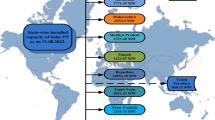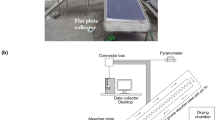Abstract
In this paper, the performance of a PVT (photovoltaic thermal) air collector with V-groove absorber in the air channel is theoretically and experimentally examined under different climate conditions of Ghaziabad city, India, in summer, June 2019. A low power brushless DC fan is fixed at the input of the air-channel to ensure the circulation of air through the V-groove. The energy balance equation is developed with the matrix-inversion method to estimate the PV (photovoltaic) cell and air output temperatures. The theoretical results obtained using mathematical modeling has been compared with that of the real-time experimental results. The electrical, thermal, and overall efficiencies for the theoretical and experimental studies are found in the range of 10.39–10.26%, 41.78–41.57%, and 52.17–51.81%, respectively. It has been observed that the theoretical results are coherent with experimental results for the proposed model achieving an accuracy of 98.98%, 99.43%, and 99.31% for electrical, thermal, and overall efficiencies, respectively.












Similar content being viewed by others
Abbreviations
- A c :
-
Collector area (m2)
- H t :
-
Collector top loss coefficient (W/m2 oC)
- H b :
-
Collector back loss coefficient (W/m2 oC)
- T c :
-
Cell temperature (oC)
- d :
-
Channel depth (m)
- D c :
-
Equivalence diameter of channel (m)
- Ex in :
-
Exergy input
- Ex out :
-
Exergy output
- T f :
-
Fluid Temperature (oC)
- m :
-
Mass flow rate (kg/s)
- A m :
-
Module area (m2)
- N u :
-
Nusselt number
- P r :
-
Prandtl number
- Re :
-
Reynolds number
- I :
-
Solar radiation (W/m2)
- C f :
-
Specific heat (J/kg oC)
- T in :
-
Temperature at the channel inlet (oC)
- T out :
-
Temperature at the channel output (oC)
- T sun :
-
Temperature of the sun (oC)
- k :
-
Thermal conductivity (W/m oC)
- Q t :
-
Usable heat (W)
- W :
-
Width of the channel (m)
- PV:
-
Photovoltaic
- PVT:
-
Photovoltaic Thermal
- HTC:
-
Heat transfer coefficients
- α:
-
Absorption coefficient
- ρ :
-
Air density (kg/m3)
- ϵ p :
-
Emissivity of PV
- ɳ ele :
-
Electrical efficiency,%
- ɳ Ex :
-
Exergy efficiency, %
- ɳ overall :
-
Overall efficiency, %
- σ :
-
Stefan Boltzman constant
- β 0 :
-
Temperature coefficient of efficiency
- µ :
-
Viscosity (kg/ms)
- ɳ th :
-
Thermal efficiency, %
- τ :
-
Transmission coefficient
- a :
-
ambient
- b :
-
backplate
- f :
-
fluid
- p :
-
photovoltaic
- r :
-
radiative
- s :
-
sky
- w :
-
wind
References
(2019) Mercom India Research: clean energy news and insights, vol 01, issue 02
Bridge to India (n.d.) Available: https://bridgetoindia.com/backend/wp-content/uploads/2019/12/India-Solar-Rooftop-map-Sep-2019.pdf
Tomar V, Tiwari G, Bhatti TS, Norton B (2018) Thermal modeling and experimental evaluation of five different photovoltaic modules integrated on prototype test cells with and without water flow. Energy Convers Manag 165:219–235
Yamawaki T, Mizukami S, Masui T, Takahashi H (2001) Experimental investigation on generated power of amorphous PV module for roof azimuth. Solar Energy Mater Solar Cells 67:369–377
Norton B, Eames PC, Mallick TC, Huang MJ, McCormack SJ, Mondol JD, Yigzaw GY (2011) Enhancing the performance of building integrated photovoltaic. Sol Energy 85(8):1629–1664
Kern EC Jr, Russell MC (1978) Combined photovoltaic and thermal hybrid collector systems. In: Proceedings of the 13th IEEE photovoltaic specialists. Washington, DC, pp 1153–7
Diwania S, Agrawal S, Siddiqui AS (2018) Performance enhancement of single-channel glazed photovoltaic thermal module using Whale Optimisation Algorithm and its comparative study. Int J Ambient Energy. https://doi.org/10.1080/01430750.2018.1537937
Tian Y, Zhao CY (2013) A review of solar collectors and thermal energy storage in solar thermal applications. Appl Energy 104:538–553
Kazemian A, Hosseinzadeh M, Sardarabadi M, Passandideh-Fard M (2018) Effect of glass cover and working fluid on the performance of photovoltaic thermal (PVT) systems. An experimental study. Sol Energy 173:1002–1010
Lammle M, Kroyer T, Fortuin S, Wiese M, Hermann M (2016) Development and modeling of highly-efficient PVT collectors with low-emissivity coatings. Sol Energy 130:161–173
Rejeb O, Dhaou H, Jemni A (2015) A numerical investigation of a photovoltaic thermal (PV/T) collector. Renew Energy 77:43–50
Yazdanifard F, Ebrahimnia-Bajestan E, Ameri M (2016) Investigating the performance of a water-based photovoltaic/thermal (PV/T) collector in laminar and turbulent flow regime. Renew Energy 99:295–306
Abbas N, Awan MB, Amer M, Ammar SM, Sajjad U, Ali HM, … Jafry AT (2019) Applications of nano-fluids in photovoltaic thermal systems: A review of recent advances. Statistical Mechanics and Its Applications, Physica A, p 122513
Sardarabadi M, Hosseinzadeh M, Kazemian A, Passandideh-Fard M (2017) Experimental investigation of the effects of using metal-oxides/water nano-fluids on a photovoltaic thermal system (PVT) from energy and exergy viewpoints. Energy 138:682–695
Ali H, Miqdam T, Hussein A, Abdulrasool H, Najah A (2017) An experimental investigation of SiC nano-fluid as a base-fluid for a photovoltaic thermal PV/T system. Energy Convers Manag 142:547–58
Singh PH, Jain A, Singh A, Arora S (2019) Influence of absorber plate shape factor and mass flow rate on the performance of the PVT system. Appl Therm Eng. https://doi.org/10.1016/j.applthermaleng.2019.04.070
Jones D, Lammle M, Theis D, Schneider S, Fray G (2019) Performance modeling of PVT collectors: Implementation, validation, and parameter identification approach using TRANSYS. Sol Energy 193:51–64
Fudholi A, Zohri M, Rukman NSB, Nazri NS, Mustapha M, Yen CH, Sopian K (2019) Exergy and sustainability index of photovoltaic thermal (PVT) air collector: A theoretical and experimental study. Renew Sustain Energy Rev 100:44–51
Salem MR, Ali RK, Elshazly KM (2017) Experimental investigation of the performance of a hybrid photovoltaic/thermal solar system using aluminium cooling plate with straight and helical channels. Sol Energy 157:147–156
Tadesse M (2017) Design, modeling, and performance analysis of parallel flow double pass V-groove solar air collector for preservation of onion in university students’ cafeteria: Wolaita Sodo University. Int J Recent Dev Eng Technol 6(6):1–12
Khanjari Y, Pourfayaz F, Kasaeian AB (2016) Numerical investigation on using of nanofluid in a water-cooled photovoltaic thermal system. Energy Convers Manag 122:263–278
Hazami M, Riahi A, Mehdaoui F, Nouicer O, Farhat A (2016) Energetic and exergetic performances analysis of a PV/T (photovoltaic thermal) solar system tested and simulated under to Tunisian (North Africa) climatic conditions. Energy 107:78–94
Jahromi SN, Vadiee A, Yaghoubi M (2015) Exergy and economic evaluation of a commercially available PV/T collector for different climates in Iran. Energy Proc 75:444–56
Ibrahim A, Fudholi A, Sopian K, Othman MY, Ruslan MH (2014) Efficiencies and improvement potential of building integrated photovoltaic thermal (BIPVT) system. Energy Convers Manag 77:527–534
Gholampour M, Ameri M (2016) Energy and exergy analyses of Photovoltaic/Thermal flat transpired collectors: experimental and theoretical study. Appl Energy 164:837–856
Wu SY, Zhang QL, Xiao L, Guo FH (2011) A heat pipe photovoltaic/thermal (PV/T) hybrid system and its performance evaluation. Energy Build 43:3558–3567
Sarhaddi F, Farahat S, Ajam H, Behzadmehr A (2010) Exergetic performance assessment of a solar photovoltaic thermal (PV/T) air collector. Energy Build 42:2184–2199
Khaki M, Shahsavar A, Khanmohammadi S, Salmanzadeh M (2017) Energy and exergy analysis and multi-objective optimization of an air based building integrated photovoltaic/thermal (BIPV/T) system. Sol Energy 158:380–395
Agrawal B, Tiwari GN (2010) Optimizing the energy and exergy of building integrated photovoltaic thermal (BIPVT) systems under cold climatic conditions. Appl Energy 87:417–426
Das D, Kalita P, Roy O (2018) Flat plate hybrid photovoltaic- thermal (PV/T) system: a review on design and development. Renew Sustain Energy Rev 84:111–130
Said SAM, Walwil HM (2014) Fundamental studies on dust fouling effects on PV module performance. Sol Energy 107:328–337
Gupta V, Sharma M, Pauchari RK, Dinesh Babu KN (2019) Comprehensive review on effect of dust on solar photovoltaic system and mitigation techniques. Sol Energy 191:596–622
Molki A (2010) Dust affects solar-cell efficiency. Phys Educ 45:456–458
Kazem HA, Khatib T, Sopian K (2013) Effect of dust deposition on the performance of multi-crystalline photovoltaic modules based on experimental measurements. Renew Energy 3:850–853
Fudholi A, Zohri M, Jin G, Ibrahim A, Yen CH, Othman MY, Ruslan MH, Sopian K (2018) Energy and exergy analysis of photovoltaic thermal collector with ∇- groove. Sol Energy 159:742–750
Diwania S, Agarwal S, Siddiqui AS, Singh S (2020) Photovoltaic–thermal (PV/T) technology: a comprehensive review on applications and its advancement. Int J Energy Environ Eng 11:33–54
Petela R (2003) Exergy of undiluted thermal radiation. Sol Energy 74(6):469–488
Kalogirou SA, Sotiriοs K, Konstantinos B, Camelia S, Badescu V (2016) Exergy energy of solar thermal collectors and processes. Prog Energy Combust Sci 56:106–137
Author information
Authors and Affiliations
Corresponding author
Ethics declarations
Conflict of interest
The authors declare that they have no known competing financial interests or personal relationships that could have appeared to influence the work reported in this paper.
Rights and permissions
About this article
Cite this article
Diwania, S., Siddiqui, A.S., Agrawal, S. et al. Performance assessment of PVT-air collector with V-groove absorber: A theoretical and experimental analysis. Heat Mass Transfer 57, 665–679 (2021). https://doi.org/10.1007/s00231-020-02980-0
Received:
Accepted:
Published:
Issue Date:
DOI: https://doi.org/10.1007/s00231-020-02980-0




